How To: Read Elena Ferrante
#1 | ‘My Brilliant Friend’ and embracing slow-form, collective criticism.

Welcome to the first instalment of a new series!
On ‘How To’, I engage with unconventional literary criticism on works, ideas, and authors that persist, are admired, or inspire emotions. It’s a way of making meaning and collecting feelings.
Other Editions | How To: #2 Read Sally Rooney
2024 saw the end of the television series adaptation of Elena Ferrante’s Neapolitan Quartet (2012-2015) — the first of which is My Brilliant Friend — translated from Italian to English by Ann Goldstein. The books continue to live and breathe, though, rendered timeless by their sheer force of narrative — the story of two friends, Elena Greco (Lenu) and Raffaella Cerullo (Lila), from childhood to adulthood and old age, set in post-war Italy.
There are many ways to read these novels — and I am convinced that rereading is the best way (which I have yet to do). I read them fairly quickly, back-to-back in 2021. Something about the pace of Lenu’s storytelling — the framing device that many critics have commented on — demanded that the story be devoured till one could circle back to Lila’s absolute disappearance, the incident that prompts Lenu to write her into presence.
But what if one employed an alternate ‘slow burn’ way of reading these brilliant books — a way of co-reading that the brilliant friends Lenu and Lila endorse in their reading and rereading (“either silently, one next to the other or aloud”) of Little Women (1868) by Louisa May Alcott as young girls, till their copy became “tattered and sweat-stained.”
Four authors set out to do this over one summer.
In The Ferrante Letters: An Experiment in Collective Criticism (2020), Sarah Chihaya, Merve Emre, Katherine Hill, and Juno Jill Richards pour over the four novels as they write letters to each other. It is personal intertextuality put into epistolary, conversational, collective, and feminist practice; it is uniquely told-as-felt.
In their own words from the Introduction,
“The Ferrante Letters offers one model for encoding the intimate labor of conversation as part of scholarship. Our goal was to formalize the texture of togetherness to show that this, as much as putting one word next to the other, is the labor of writing.”
And,
“[I]t brings to life ongoing possibilities for transforming the personal into feminist praxis—a critical experiment with no defined end… The gamble of The Ferrante Letters, like the gamble of the Neapolitan Quartet, is its willingness to enmesh literature and criticism in the web of lived relations among daughters, mothers, wives, colleagues, advisors, and friends.”
The conversation between the writers ebbs and flows; they circle back, expand, emphasise, and retrace.
The most obvious conversation erupts on the “economy of two” and the “familiar dyads” that are Lenu and Lila, captured in the bidirectional force of the title of the first book (My Brilliant Friend) — Lila is Lenu’s brilliant friend, while Lenu is Lila’s.
There is something particular about their friendship that makes us pick a side, the writers agree. This friendship is built on “fantastic projections” as all friendships are, says one letter. Another letter adds that if all friends are imaginary — if you cannot truly know the other person — then “what is friendship but a shared fiction, an atmosphere… that exists only because both parties believe in it?”
Emre’s letter about Lenu’s “productive anger” is my favourite from the collection; it is the kind of conversation I like to have about these novels (and sometimes literature, in general) — “What does it mean to write angrily?”
When Lenu, in her sixties, begins writing the story, she says of Lila,
“She [Lila] wanted not only to disappear herself, now, at the age of sixty-six, but also to eliminate the entire life she had left behind. I was really angry. We’ll see who wins this time, I said to myself. I turned on the computer and began to write...”
There is a lot of anger, often leading to violence, in Lenu and Lila’s world, but this “productive anger” — this anger that leads to writing — is a creative framing device that encloses the entire narrative of these books. Emre writes that the fact that both Lenu and Lila have an appreciation for literature, Lenu believes, “sets the girls and their friendship apart from the anger of Naples as they grow older.”
So, the strong “We’ll see who wins this time,” Emre writes, “may seem spiteful, but it is in fact a return to a purer scene of literary togetherness” — the reading of Little Women together, again and again — before literary pleasure became associated with wealth and class, and before the anger of the real world took over.
In this sense, Emre proposes, the story of the brilliant friends is a “twinned Künstlerroman” —
“[T]he portrait of the artist as not one but two young women; a portrait limned by the convergences of language and the divergences of class.”
These convergences and divergences intertwine Lenu and Lila, Chihaya writes in another letter, in a “lifelong dialogue (about each other, themselves, and the world they live in),” which makes us contemplate “what it means to dwell with books, with the stories of our lives and others, both alone and together.”
On embracing this contemplative impulse, this slow-form criticism, Chihaya offers —
““The Slow Burn” is an experiment in what I’ve been thinking of as slow-form criticism: readings that happen on the back burner while your mind is mostly elsewhere, that, in their extended simmering, develop a different richness and depth over time from a quick-fired review.”
Complement this with what Lenu thinks in Those Who Leave and Those Who Stay (2014) —
“The solitude of women’s minds is regrettable. It’s a waste to be separated from each other without procedures, without tradition.”



Thank you. This sounds like a lovely experiment in criticism.